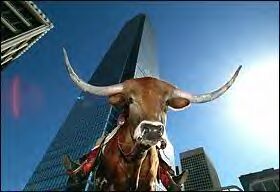
Light Rail Now and Walkable Neighborhoods (LRN) can be contacted at: Light Rail Now! |
The Dallas success story is a bitter pill for LRT opponents. So to try to demonstrate that DART's LRT system is an abject failure, they've had to clutch at straws.
Thus Cox has claimed that downtown Dallas – booming with new buildings and rehabilitated building construction, and the flourishing of areas like the West End restaurant district – is actually in a de facto economic "recession". This venture into absurdity alone should raise eyebrows in regard to Cox's supposedly "professional" competency. But the question remains – if the light rail system is so successful, why is the vacancy rate so high? The truth is that Dallas's downtown has suffered from a chronically high office vacancy rate for many years, prior to the inauguration of light rail. The downtown decline basically started with the abandonment of Dallas's earlier electric rail system in the late 1950s, but it was given a boost with the furious overbuilding by real estate promoters during the 1980s, followed by a series of economic slumps which left downtown Dallas in an overbuilt situation. As the chart below indicates (showing vacancy trends from the first quarter 1995 through the first quarter 2000), the startup of DART's new light rail system has apparently reversed the vacancy trend, which peaked at 36.4% just before light rail began running in June 1996 and has been on a downward trend since then – hitting 27.6% in the first quarter of this year. Light rail thus has evidently helped provide an important economic boost to downtown Dallas!
Furthermore, according to M/PF research (information provided to us by DART), Class "A" real estate in downtown Dallas was 91% occupied as of the 3rd quarter of 1999. Downtown and adjacent uptown Dallas actually have the tightest Class A markets across the D/FW area. Class C property (which includes many abandoned warehouses and similar properties) has a higher vacancy rate ... but that is changing. Class C property is being transformed into new properties like the Magnolia Hotel.
People are also moving downtown to live. There are more than 10,000 permanent residents now living downtown compared to only a few hundred prior to the introduction of rail. Research by the Downtown improvement District concluded "Downtown's residential population is growing at a rate equal to suburban areas such as Plano, Lewisville and McKinney." Conclusion: Far from stagnation and a "recession", DART's new LRT is spearheading an economic and urban renaissance in downtown Dallas. Light Rail Progress Rev. 2001/07/20 |
|
|
|